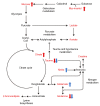1H-NMR-based metabolomic analysis of cerebrospinal fluid from adult bilateral moyamoya disease: comparison with unilateral moyamoya disease and atherosclerotic stenosis
- PMID: 25929894
- PMCID: PMC4603033
- DOI: 10.1097/MD.0000000000000629
1H-NMR-based metabolomic analysis of cerebrospinal fluid from adult bilateral moyamoya disease: comparison with unilateral moyamoya disease and atherosclerotic stenosis
Abstract
Although metabolomics has been increasingly used to observe metabolic pattern and disease-specific metabolic markers, metabolite profiling for moyamoya disease (MMD) has not yet been done in adults. This study investigated cerebrospinal fluid (CSF) metabolites specific to bilateral MMD (B-MMD) and compared them to those of unilateral MMD (U-MMD) or atherosclerotic stenosis with hydrogen-1 nuclear magnetic resonance spectroscopy to identify metabolic biomarkers associated with MMD in adults.CSF samples of B-MMD (n = 29), U-MMD (n = 11), and atherosclerotic cerebrovascular disease (ACVD) (n = 8) were recruited. Principal component analysis, partial least square discriminant analysis, and orthogonal projections to latent structure discriminant analysis (OPLS-DA) were done for the comparisons. Diagnostic performance was acquired by prediction of 1 left-out sample from the distinction model constructed with the rest of the samples.B-MMD showed an increase in glutamine (P < 0.001) and taurine (P = 0.004), and a decrease in glucose (P < 0.001), citrate (P = 0.002), and myo-inositol (P = 0.006) than those in ACVD. U-MMD showed a higher level of glutamine (P = 0.005) and taurine (P = 0.034), and a lower level of glutamate (P < 0.004) than those in ACVD. No difference at the metabolite level was observed between B-MMD and U-MMD. Cross-validation with the OPLS-DA model showed a high accuracy for the prediction of MMD.The results of the study suggest that a metabolomics approach may be helpful in confirming MMD and providing a better understanding of MMD pathogenesis. Elevated glutamine in the CSF may be associated with MMD pathogenesis, which was different from ACVD.
Conflict of interest statement
The authors have no conflicts of interest to disclose.
Figures




Similar articles
-
Expression of cellular retinoic acid-binding protein-I (CRABP-I) in the cerebrospinal fluid of adult onset moyamoya disease and its association with clinical presentation and postoperative haemodynamic change.J Neurol Neurosurg Psychiatry. 2014 Jul;85(7):726-31. doi: 10.1136/jnnp-2013-305953. Epub 2013 Nov 29. J Neurol Neurosurg Psychiatry. 2014. PMID: 24292994
-
Study on plasmatic metabolomics of Uygur patients with essential hypertension based on nuclear magnetic resonance technique.Eur Rev Med Pharmacol Sci. 2014;18(23):3673-80. Eur Rev Med Pharmacol Sci. 2014. PMID: 25535139
-
Identification of novel biomarker candidates by proteomic analysis of cerebrospinal fluid from patients with moyamoya disease using SELDI-TOF-MS.BMC Neurol. 2010 Nov 8;10:112. doi: 10.1186/1471-2377-10-112. BMC Neurol. 2010. PMID: 21059247 Free PMC article.
-
Metabolic profiling in multiple sclerosis and other disorders by quantitative analysis of cerebrospinal fluid using nuclear magnetic resonance spectroscopy.Curr Pharm Biotechnol. 2011 Jul;12(7):1016-25. doi: 10.2174/138920111795909122. Curr Pharm Biotechnol. 2011. PMID: 21466459 Review.
-
Potential predictors for progression of moyamoya disease: A systematic review and meta-analysis.Front Neurol. 2023 Mar 2;14:1128338. doi: 10.3389/fneur.2023.1128338. eCollection 2023. Front Neurol. 2023. PMID: 36937514 Free PMC article.
Cited by
-
Liquid chromatography coupled to mass spectrometry metabolomic analysis of cerebrospinal fluid revealed the metabolic characteristics of moyamoya disease.Front Neurol. 2024 Feb 15;15:1298385. doi: 10.3389/fneur.2024.1298385. eCollection 2024. Front Neurol. 2024. PMID: 38426176 Free PMC article.
-
Advances in moyamoya disease: pathogenesis, diagnosis, and therapeutic interventions.MedComm (2020). 2025 Jan 14;6(2):e70054. doi: 10.1002/mco2.70054. eCollection 2025 Feb. MedComm (2020). 2025. PMID: 39822761 Free PMC article. Review.
-
Multiomics and blood-based biomarkers of moyamoya disease: protocol of Moyamoya Omics Atlas (MOYAOMICS).Chin Neurosurg J. 2024 Feb 8;10(1):5. doi: 10.1186/s41016-024-00358-3. Chin Neurosurg J. 2024. PMID: 38326922 Free PMC article.
-
Metabolomic Profiling Revealed Potential Biomarkers in Patients With Moyamoya Disease.Front Neurosci. 2020 Apr 21;14:308. doi: 10.3389/fnins.2020.00308. eCollection 2020. Front Neurosci. 2020. PMID: 32372905 Free PMC article.
-
A Recent Update of Clinical and Research Topics Concerning Adult Moyamoya Disease.J Korean Neurosurg Soc. 2016 Nov;59(6):537-543. doi: 10.3340/jkns.2016.59.6.537. Epub 2016 Oct 24. J Korean Neurosurg Soc. 2016. PMID: 27847564 Free PMC article. Review.
References
-
- Scott RM, Smith ER. Moyamoya disease and moyamoya syndrome. N Engl J Med 2009; 360:1226–1237. - PubMed
-
- Houkin K, Ito M, Sugiyama T, et al. Review of past research and current concepts on the etiology of moyamoya disease. Neuro Med Chir (Tokyo) 2012; 52:267–277. - PubMed
-
- Kim JE, Jeon JS. An update on the diagnosis and treatment of adult moyamoya disease taking into consideration controversial issues. Neurol Res 2014; 36:407–416. - PubMed
-
- Cho WS, Kim JE, Kim CH, et al. Long-term outcomes after combined revascularization surgery in adult moyamoya disease. Stroke 2014; 45:3025–3031. - PubMed
-
- Kuroda S, Ishikawa T, Houkin K, et al. Incidence and clinical features of disease progression in adult moyamoya disease. Stroke 2005; 36:2148–2153. - PubMed
Publication types
MeSH terms
Substances
Supplementary concepts
LinkOut - more resources
Full Text Sources

